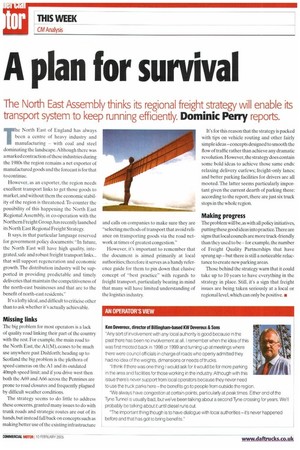A plan for survival
Page 20

If you've noticed an error in this article please click here to report it so we can fix it.
The North East Assembly thinks its regional freight strategy will enable its transport system to keep running efficiently. Dominic Perry reports.
The North East of England has always been a centre of heavy industry and manufacturing with coal and steel dominating the landscape. Although there was a marked contraction of these industries during the 1980s the region remains a net exporter of manufactured goods and the forecast is for that to continue.
However, as an exporter, the region needs excellent transport links to get those goods to market, and without them the economic stability of the region is threatened. To counter the possibility of this happening the North East Regional Assembly, in co-operation with the Northern Freight Group, has recently launched its North East Regional Freight Strategy.
It says. in that particular language reserved for government policy documents: "In future, the North East will have high quality. integrated, safe and robust freight transport links... that will support regeneration and economic growth. The distribution industry will be supported in providing predictable and timely deliveries that maintain the competitiveness of the north-east businesses and that are to the benefit of north-east residents."
It's a lofty ideal, and difficult to criticise other than to ask whether it's actually achievable.
Missing links The big problem for most operators is a lack of quality road linking their part of the country with the rest. For example, the main road to the North East, the Al (M), ceases to be much use anywhere past Dishforth: heading up to Scotland the big problem is the plethora of speed cameras on the Al and its outdated 40mph speed limit; and if you drive west then both the A69 and A66 across the Pennines are prone to road closures and frequently plagued by difficult weather conditions.
The strategy seems to do little to address these concerns, granted many issues to do with trunk roads and strategic routes are out of its hands, but instead fall back on concepts such as making better use of the existing infrastructure and calls on companies to make sure they are "selecting methods of transport that avoid reliance on transporting goods via the road network at times of greatest congestion."
However, it's important to remember that the document is aimed primarily at local authorities; therefore it serves as a handy reference guide for them to pin down that elusive concept of "best practice" with regards to freight transport. particularly bearing in mind that many will have limited understanding of the logistics industry. It's for this reason that the strategy is packed with tips on vehicle routing and other fairly simple ideas-concepts designed to smooth the flow of traffic rather than achieve any dramatic revolution. However, the strategy does contain some bold ideas to achieve those same ends: relaxing delivery curfews; freight-only lanes; and better parking facilities for drivers are all mooted. The latter seems particularly important given the current dearth of parking there: according to the report, there are just six truck stops in the whole region.
Making progress
The problem will be, as with all policy initiatives, putting these good ideas into practice.There are signs that local councils are more truck-friendly than they used to be for example, the number of Freight Quality Partnerships that have sprung up but there is still a noticeable reluctance to create new parking areas.
Those behind the strategy warn that it could take up to 10 years to have everything in the strategy in place. Still, it's a sign that freight issues are being taken seriously at a local or regional level, which can only be positive. •






































































































































































































